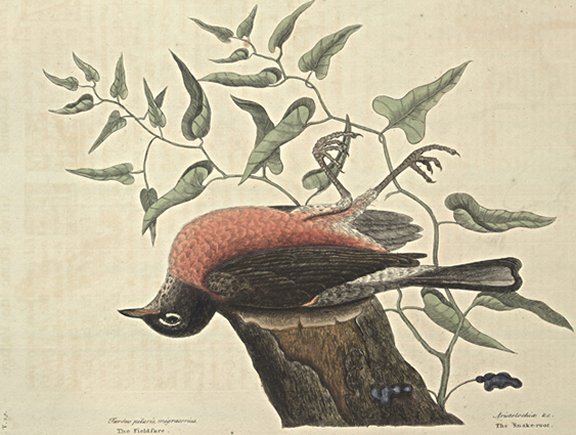Plate Number: I 29Turdus Pilaris, Migratorius: The Fieldfare of Carolina Weighs two ounces, three quarters; about the size and shape of the European Field fare. That part of the Bill, next the Head, is yellow. Over and under the Eye are two white streaks. The upper part of the Head is black, with a mixture of Brown. The Wings and upper part of the Body brown: The Tail dark-brown: The Throat black and white: The Breast and Belly red: The Legs and Feet brown. In Winter they arrive from the North in Virginia and Carolina, in numerous Flights, and return in the Spring as ours in England. They are canorous, having a loud Cry like our Missel-bird, which the following Accident gave me an opportunity of knowing: Having some Trees of Alaternus full of Berries (which were the first that had been introduced in Virginia) a single Feildfare seemed so delighted with the Berries, that he tarried all the Summer feeding on them. In Maryland, I am told, they breed and abide the whole year. Aristolochia pistolochia Seu Serpentaria Virginiana caule nodoso: The Snake-Root of VirginiaThis Plant rises out of the Ground in one, two, and sometimes three pliant Stalks, which at every little distance are crooked, or undulated. The Leaves stand alternately, and are about three inches long, in form somewhat like the Smilax aspera. The Flowers grow close to the ground on foot-stalks an inch long, of a singular shape, though somewhath resembling those of the Birthworts, of a dark purple colour. A round chanulated capsula succeeds the Flower, containing many small Seeds, which are ripe in May. The usual price of this excellent Root, both in Virginia and Carolina, is about six pence a Pound when dried, which is Money hardly earned. Yet the Negro Slaves (who only dig it) employ much of the little time allowed them by their Masters in search of it; which is the Cause of there being seldom found any but very small Plants. By planting them in a Garden they increased so in two years time, that one's hand could not grasp the stalks of one Plant. It delights in shady woods, and is usually found at the Roots of great Trees. |